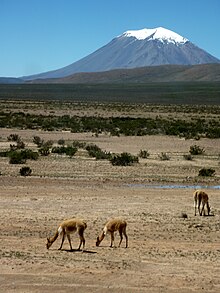Misti
| Misti | ||
|---|---|---|
|
Misti |
||
| height | 5822 m | |
| location | Peru | |
| Mountains | To the | |
| Coordinates | 16 ° 17 ′ 51 ″ S , 71 ° 24 ′ 21 ″ W | |
|
|
||
| Type | Stratovolcano | |
| Last eruption | 1784 | |
The Misti is a stratovolcano in the south of Peru in the immediate vicinity of the city of Arequipa . The volcano dominates the cityscape with its distinctive conical shape and is therefore considered a symbol of Arequipa. The mountain can also be found in the city arms. The 5822 meter high Misti lies between two other volcanoes, the 6075 meter high Nevado Chachani and the Picchu Picchu . A 6 m high cross made of iron rails was erected on the summit of Misti.
The last major eruption occurred in 1784. The volcano is still active. The Misti has three concentric craters. Again and again, smoking fumaroles can be observed from Arequipa . Geologists have verified at least 20 eruptions with tephra deposits in the past 50,000 years. Around 2000 years ago, a pyroclastic flow reached a length of 12 kilometers.
NASA experts assume that lava flows, lahars and glowing avalanches in the event of an eruption endanger the 850,000 inhabitants of the city of Arequipa. However, there are no evacuation plans and, despite the danger, new settlements are being built on the slopes of the volcano. The people of Arequipa call the volcano "dormant".
The German-Peruvian general and cartographer Clemens von Althaus (1791–1836) was probably the first to climb the Misti, and certainly the first to thoroughly examine and describe the volcano. In 1998, archaeologists found six mummies and rare artifacts from the Inca era near the crater. They are now in the Museo de Santuarios Andinos in Arequipa.
With its regular cone shape, the mountain is reminiscent of a huge pile of sand. Technically, climbing the Misti does not present any difficulties. However, due to the loose, slippery volcanic ash and steep slopes, the climb is very arduous. Good acclimatization and fitness are required. In a few months there may be snow, then crampons and ice axes may be necessary. However, most of the year the summit is free of snow due to the drought.
See also
Footnotes
- ↑ Flora Tristan : My trip to Peru . Societäts-Verlag, Frankfurt am Main 1983. ISBN 3-7973-0406-4 . P. 160f.
Web links
- Misti in the Global Volcanism Program of the Smithsonian Institution (English)
- Report of an ascent with photos
- Description of ascent
- Misti on visibleearth.nasa.gov
- Misti volcano fascination: Nov. 2012


